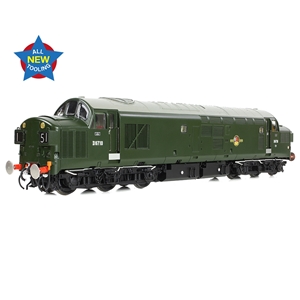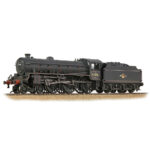The Class 158 is one of British Rail’s most successful second generation Diesel Multiple Units (DMUs); first introduced in 1989, all but one of the original units remain in traffic to this day. This all-new Graham Farish model follows in the footsteps of the brand’s award winning Class 319 Electric Multiple Unit and captures this iconic prototype to a tee.
The pinnacle of N scale second generation DMUs, the Graham Farish Class 158 combines high fidelity bodyshells with an underframe that’s adorned with separate components depicting the engines, electrical equipment, and auxiliary gear. It’s the livery application which really brings these models to life and every element has been replicated in miniature. Whilst the main colours are spray painted, the myriad smaller logos, symbols and lettering are applied using a specialist printing process, using BR and corporate specification fonts, logos and colours.
Driven by the low-level drive mechanism, each vehicle sports uninterrupted views of the interior which is fitted out with tables, chairs and even metal luggage racks – made visible thanks to the saloon lighting. The inter-vehicle coupling system ensure that the two vehicles work together in harmony and enables the use of a single decoder for DCC operation. This SOUND FITTED model comes pre-fitted with a DCC sound decoder, providing realistic sound effects when used on both analogue control and DCC straight out of the box.
- Graham Farish N Scale
- Era 9
- Pristine GWR (FirstGroup) livery
- Running No. 158750
- Two-Car Unit comprising car Nos. 52750 & 57750
- Destination blinds for Penzance
- SOUND FITTED – Fitted with a Zimo MS590N18 DCC Sound Decoder – See below for the function list
- Length 315mm
DETAIL VARIATIONS SPECIFIC TO THIS MODEL
- Radio Pod on Roof
- Revised Air Conditioning (Type A)
- Toilet Discharge via CET Tank
- Cummins Engine
- Revised Heather
- Scottish Air Dam
- Sanding Gear Fitted
- Revised LED Light Cluster
- Plated Gangway Doors
GRAHAM FARISH CLASS 158 SPECIFICATION
MECHANISM:
- Coreless, twin shaft motor with two flywheels providing drive to both bogies of the DMS (A) vehicle
- Four axle drive (all axles on the DMS (A) vehicle)
- Electrical pickup from all wheels
- Trailing axles run in metal pinpoint bearings (all axles on the DMS (B) vehicle)
- Gearing arranged for prototypical running speeds and haulage capabilities
- 9mm (N gauge) wheels to NEM310 standards with authentic profile and detailing
- Working miniature BSI Couplings at the cab ends (alternative air dams are included to allow this feature to work on second radius curves or less)
- Close coupling mechanism with integral conductive couplings fitted between vehicles
- Designed to operate on curves of second radius (263.5mm) or greater
DETAILING:
- Highly detailed bodyshell with flush, tinted glazing
- Unobstructed interior including seat and table detail
- Bogies constructed from multiple components featuring full relief detail
- Separately applied underframe equipment and detail components
- Separately applied metal detail parts, including exhaust guards and interior luggage racks
- Each model is supplied with an accessory pack comprising exhaust pipes and cab end connector door covers (where appropriate)
LIGHTING:
- Directional lighting, including illuminated destination panels, switchable on/off at either end on DCC or Analogue control
- Cab and saloon interior lighting, switchable on/off via the under-chassis switches
- Authentic light colours and temperatures selected for each model based on era and application
DCC:
- Next18 DCC decoder interface – one decoder required per unit
- Easy-access DCC decoder socket located behind removable panel on underside of DMS (B)
SOUND:
- Speaker installed in all models for optimum sound reproduction
- Zimo MS590N18 DCC Sound Decoder fitted to SOUND FITTED versions
- Sound files produced specifically for the Graham Farish Class 158 using recordings from real units
- SOUND FITTED models operate on DCC and Analogue control as supplied
LIVERY APPLICATION:
- Authentic liveries applied to all models
- Multiple paint applications employed on each model using BR/TOC specification colours
- Logos, numerals and text added as appropriate using multi-stage tampo printing using authentic typefaces, logos and colours
SOUNDS
F0 – Directional Lights – On / Off
F1 – On – Warm Start / F5 – On, then F1 – On – Cold Start
F2 – Brake (Non-Latching)
F3 – Single Horn
F4 – Two-Tone Horn
F5 – Light Engine / Cold Engine Start
F6 – Engine Idle / Coasting
F7 – Flange Squeal
F8 – On – Doors Opening (F1 On) / Off – Doors Closing (F1 On)
F9 – Dispatch Whistle
F10 – On – Guard’s Buzzer (Single) / Driver’s Response Buzzer (Single)
F11 – On – Guard’s Buzzer (Double) / Driver’s Response Buzzer (Double)
F12 – Engine Speed Up
F13 – Air Conditioning Fan
F14 – Windscreen Wipers
F15 – On – Doors Opening (F1 Off) / Off – Doors Closing (F1 Off)
F16 – Fade All Sounds
F17 – Directional Lights Off (Car A, 57xxx)
F18 – Directional Lights Off (Car B, 52xxx)
F19 – Station Ambience
F20 – Remote Telephone Test
F21 – Detonators
F22 – AWS
F23 – F26 – No User Access
F27 – Volume Down
F28 – Volume Up
Analogue Users: Please note that basic prime mover sounds will operate and will vary according to use when this model is used on analogue control (DC) straight from the box! Directional lights and passenger compartment lights will also illuminate when power is applied.
CLASS 158 DMU HISTORY
The British Rail Class 158 Express Sprinter is a Diesel Multiple Unit (DMU), built specifically for British Rail’s Provincial Services sector between 1989 and 1992 by British Rail Engineering Limited (BREL) at Derby Litchurch Lane Works and outshopped in Regional Railways Provincial livery. They were built to replace many locomotive-hauled passenger trains, thereby reducing cost of operation, and to allow cascading of existing Sprinter units to replace elderly ‘heritage’ DMUs. The majority of the 182-strong fleet of Class 158 units were built as two-car sets, with 17 three-car units constructed specifically for use on Trans-Pennine services. Similar three-car units were built for use by Network SouthEast but these were converted to Class 159 specification before introduced into service, with toilet retention tanks and other modifications to operate over the third-rail network.
All but one of the Class 158s remain in service today (2023), with operators including ScotRail, Northern, Great Western (GWR), East Midlands Trains (now EMR), and Transport for Wales (formerly Arriva). Former operators include Central Trains. The Class has worked extensively across the UK network, even into East Anglia as far as Stansted Airport and Norwich. Some 158s have been converted to additional Class 159s and now operate for South Western alongside their original classmates.
























